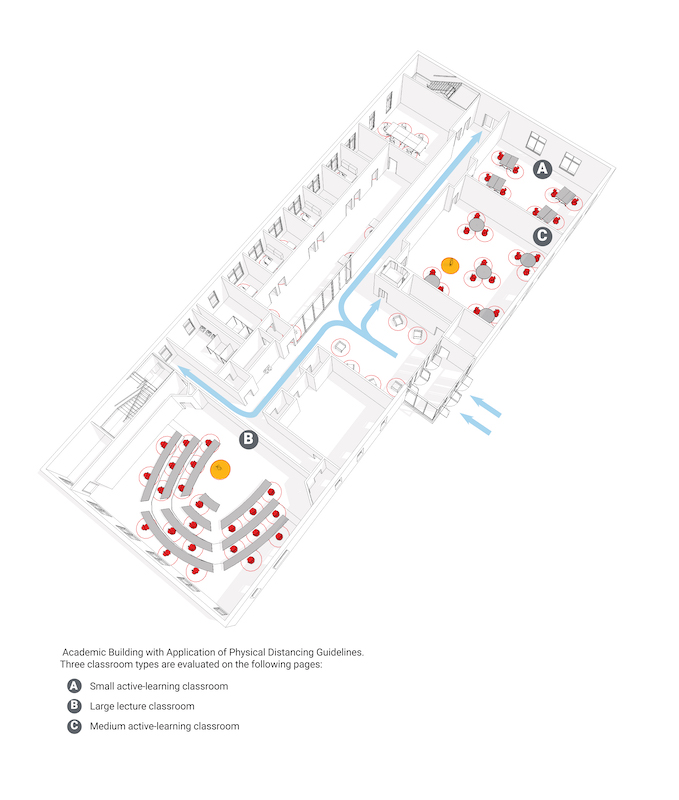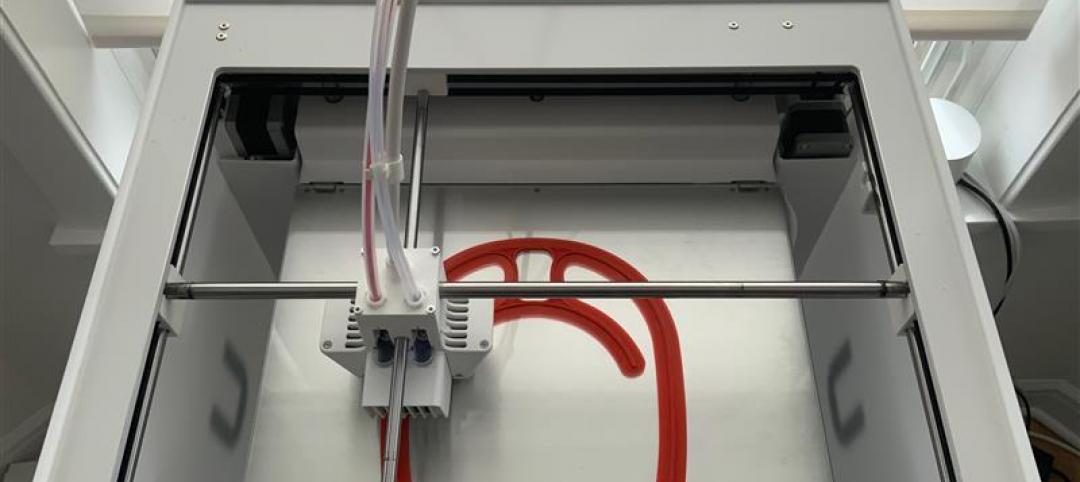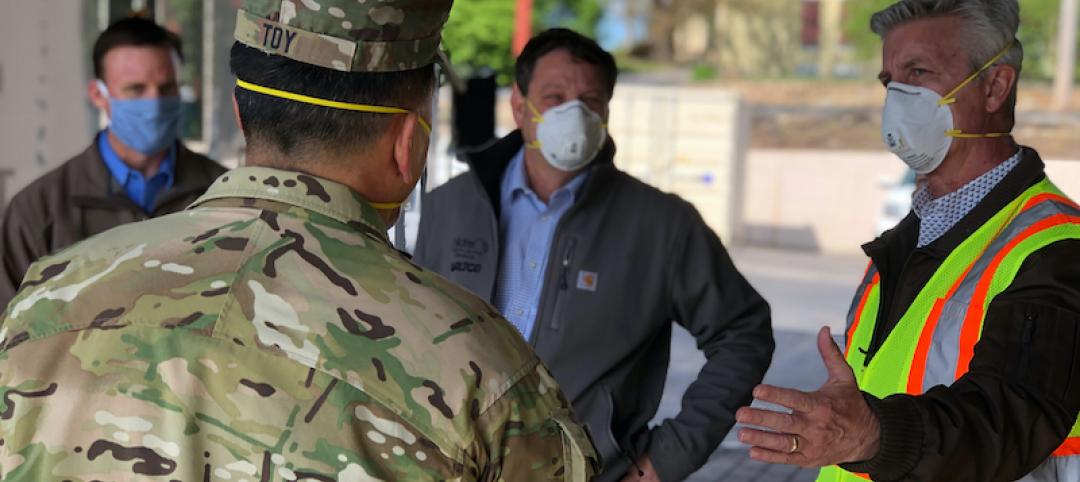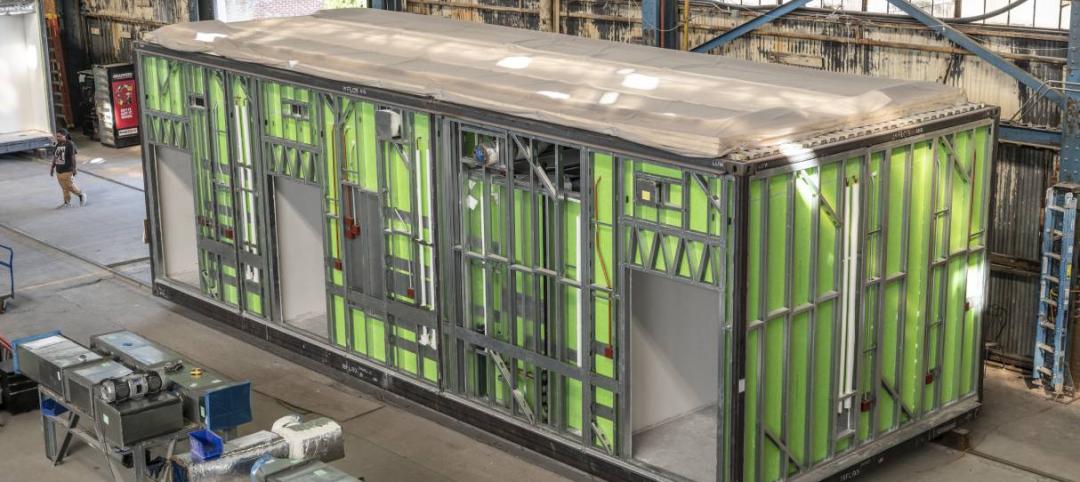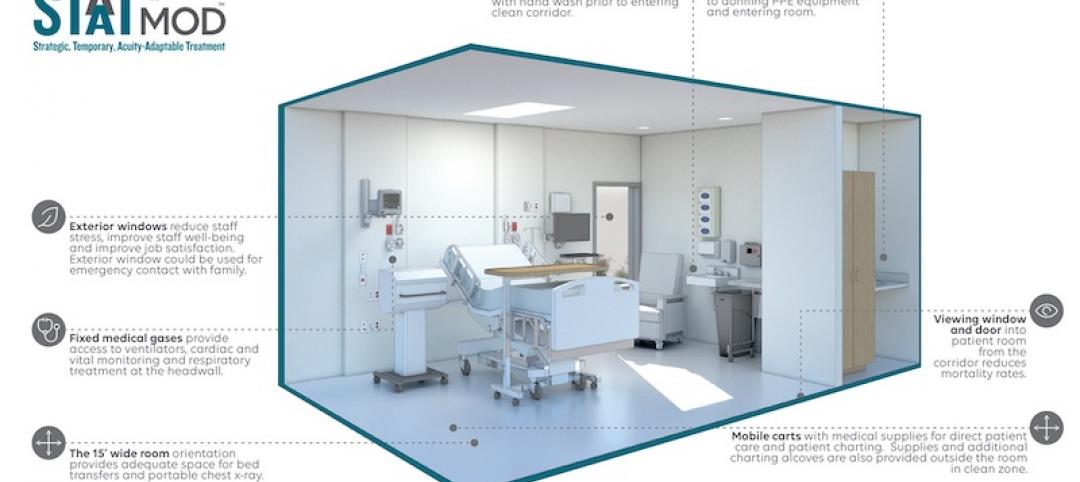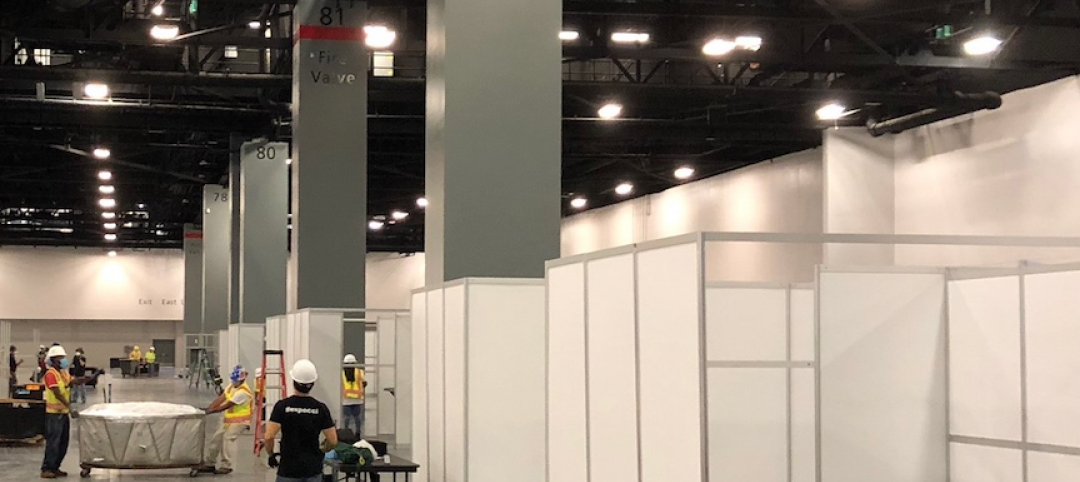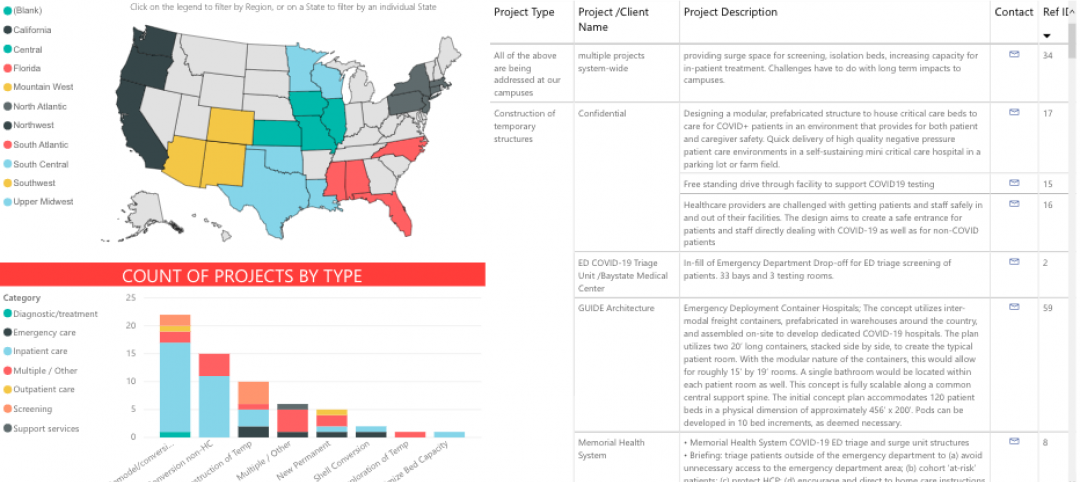As colleges and universities weigh how to reopen their campuses in the fall, the standard government, health, and academic guidelines—wearing masks, reducing densities, and physical distancing—may not be entirely practical for assembling large numbers of students in one place.
To contribute to this discourse, Leo A Daly recently convened planners, architects, and engineers specializing in higher education to study the facility impacts of physical distancing, and to envision solutions.
This group analyzed available guidelines, and then applied design thinking to three key areas. First, it studied infection dynamics on the campus overall and applied the idea of “cohorts” as a mechanism for limiting exposure. Next, the group conducted a detailed study of two campus building types where students congregate: a general purpose academic building and a “traditional” residence hall with shared toilet and shower facilities. These analyses identified “pinch points,” suggesting the need for behavioral and physical modifications to more closely comply with the intent of the guidelines.
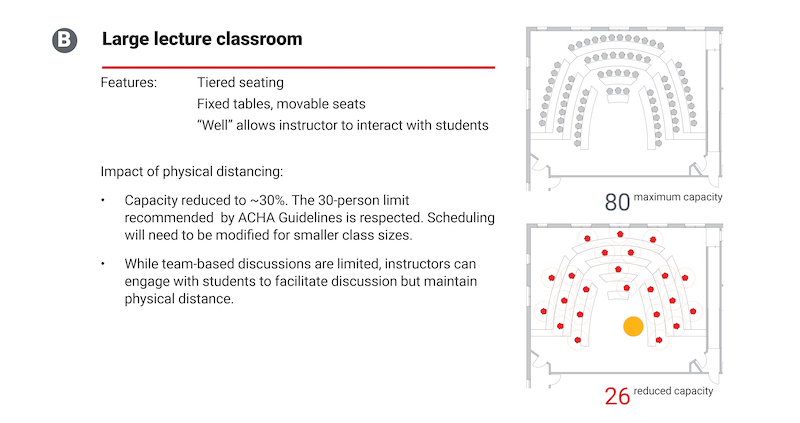 Reducing the number of students in a lecture hall might actually improve instructor engagement.
Reducing the number of students in a lecture hall might actually improve instructor engagement.
A white paper, “Returning to Campus During the Covid-19 Pandemic,” summarizes the group’s findings and recommendations. “The analysis suggests that organizing students into cohorts, and considering rental or toilet and shower facilities, can improve safety where strict compliance of guidelines isn’t feasible,” the report states.
Also see: How to convert college dorms to support the coronavirus crisis
ADDING SAFETY BY DIVIDING STUDENTS INTO SMALL GROUPS
Breaking students into smaller cohorts can help institutions determine roommates and how shared spaces are used. That division can also be extended to academic buildings to create live-learn facilities. The division of students further into micro-communities “would allow students to retain the benefits of social communication while reducing their exposure to pathways of disease common to a large, dense campus,” the white paper’s three authors write.
The paper stresses one-way circulation in academic buildings that would also have a single point of entry, directional signage, and multiple exits. To minimize disease transmission in restrooms, measures might include using alternating stalls and sings, no-touch fixtures and hardware, and frequent cleaning and disinfection. To reduce pinch points, the paper recommends adding toilet capacity by installing temporary trailers with single-use facilities inside trailers adjacent to the building.
The report provides guidelines for small and medium active-learning classrooms, large lecture classrooms (in which it recommends a 30% capacity reduction to a 30-person maximum).
MAKING RESIDENCE HALLS (AND THEIR BATHROOMS) SAFER
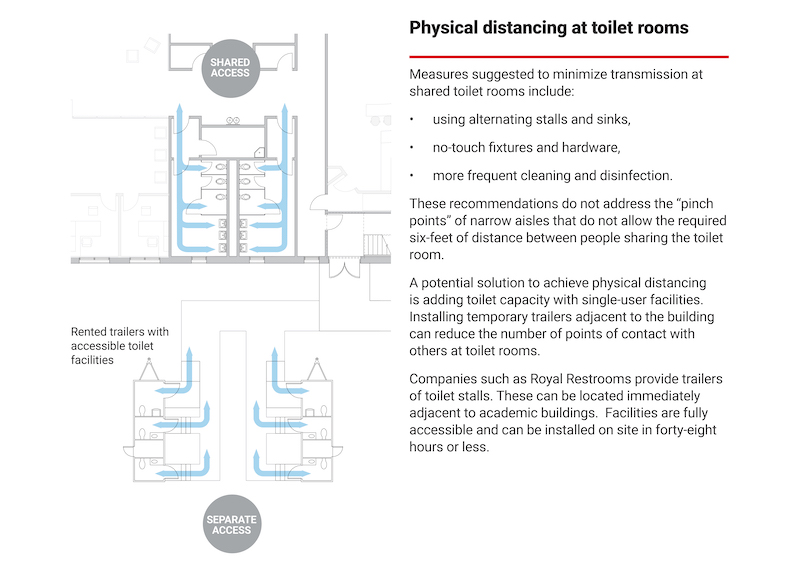 Extending restroom access by installing temporary facilities near academic and residence buildings would minimize disease transmission.
Extending restroom access by installing temporary facilities near academic and residence buildings would minimize disease transmission.
For residence halls, the report thinks that toilets and showers can still be shared, albeit with some changes that include the installation of automatic openings at common doors, assigning student rooms as single occupancy, and converting shower rooms to function as single-occupancy rooms by adding a door and restricting access.
The report suggests that assigning a shower stall to just two living units would reduce the potential for cross contamination among student residents. (Such separations could be achieved by color-coding the stalls.) At shared toilet sites, no-touch or at least reduced-touch fixtures should be standard.
Schools should treat existing shared bathrooms as single use, and reserve them for select students. Other students can be provided bathrooms in the form of temporary facilities adjacent to the resident hall and accessible by a covered hallway. (The report states that a three-unit combined shower, toilet, and lavatory can be rented for $5,500 per month, to start.)
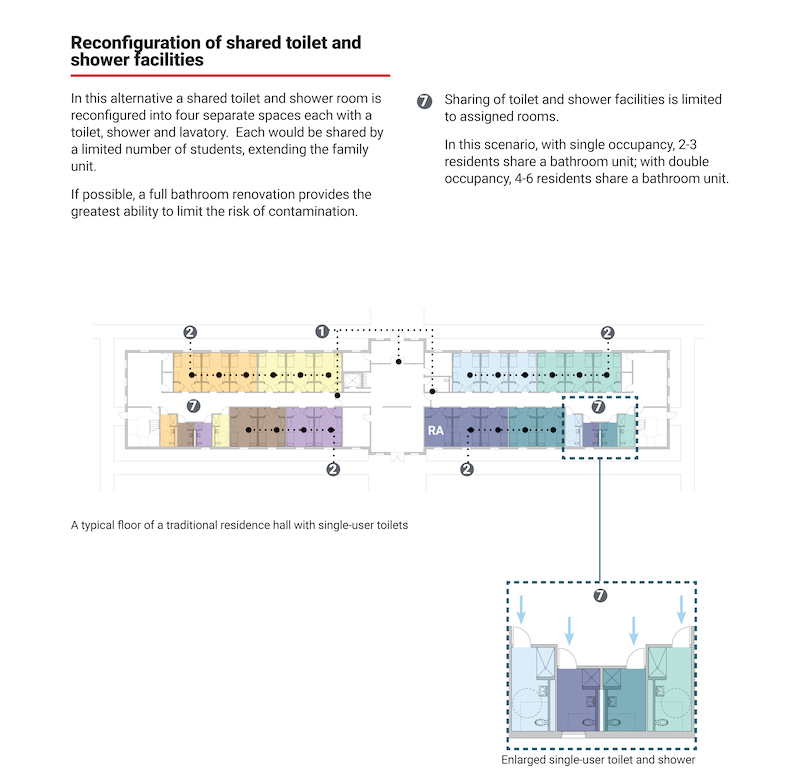
As an alternative, shared toilet and shower rooms can be reconfigured into four separate spaces, each shared by a limited number of students and assigned rooms.
Colleges and universities might also consider building systems that are more focused on occupant health, and incorporating UV-C lighting, which has been shown to kill pathogens.
Related Stories
Coronavirus | Apr 15, 2020
3D printing finds its groove fabricating face shields during COVID-19 crisis
The architecture firm Krueck + Sexton is producing 100 shields for a Chicago-area hospital.
Coronavirus | Apr 14, 2020
COVID-19 alert: Missouri’s first Alternate Care Facility ready for coronavirus patients
Missouri’s first Alternate Care Facility ready for coronavirus patients
Coronavirus | Apr 13, 2020
COVID-19 alert: City conducts a 'virtual building inspection' to allow Starbucks and bank to open
Bothell, Wash., issues a certificate of occupancy to developer after inspecting the property online.
Coronavirus | Apr 13, 2020
Construction layoffs spread rapidly as coronavirus shuts down projects, in contrast to job gains through February in most metros
Association officials urge quick enactment of infrastructure investment, relief for hard-hit firms and pensions in order to save jobs in construction and supplier industries.
Coronavirus | Apr 12, 2020
How prefab can enable the design and construction industry to bring much needed beds to hospitals, faster
The outbreak of COVID-19 represents an unprecedented test for the global healthcare system. Managing the pandemic—and saving lives—depends largely on the availability of medical supplies, including the capacity of hospitals. But the United States lags behind other nations, with only 2.8 beds per thousand people compared to 4.3 in China and 12.8 in South Korea.
Coronavirus | Apr 10, 2020
HGA and The Boldt Company devise a prefabricated temporary hospital to manage surge capacity during a viral crisis
A STAAT Mod system can be ready to receive patients in less than a month.
Coronavirus | Apr 10, 2020
COVID-19: Converting existing hospitals, hotels, convention centers, and other alternate care sites for coronavirus patients
COVID-19: Converting existing unused or underused hospitals, hotels, convention centers, and other alternate care sites for coronavirus patients
Coronavirus | Apr 9, 2020
COVID-19 Design Innovation Grant: IDA offers $14,000 to spur design innovation for combating the coronavirus pandemic
The International Design Awards is looking for innovations in low-cost ventilators, in-home isolation pods, and reusable masks.
Coronavirus | Apr 9, 2020
COVID-19 alert: Robins & Morton to convert Miami Beach Convention Center into a 450-bed field hospital
COVID-19 alert: Robins & Morton to convert Miami Beach Convention Center into a 450-bed field hospital
Coronavirus | Apr 8, 2020
AIA task force launches tool for assessing COVID-19 alternative care sites
The tool is intended to assist non-healthcare design professionals with identifying alternative sites suitable for patient care.


